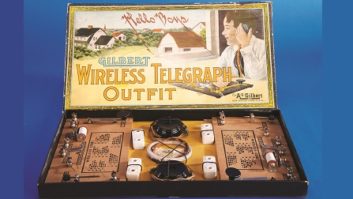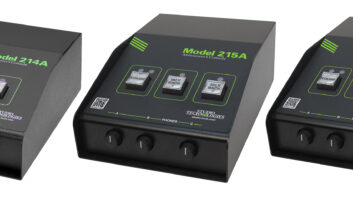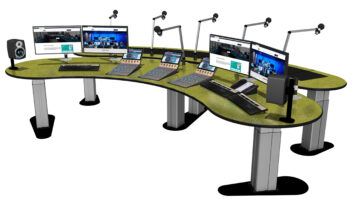(click thumbnail)Fig. 1: The ‘dancer pole’ wasn’t designed with radio in mind. We highlighted a station in Thomas Jefferson’s hometown of Charlottesville, Va., a while back. Eure Communications used “Jeffersonian” style columns in their studios to run wires from the console tabletop to the ceiling. A unique way to hide wires, and still keep a colonial Virginia theme.
So what do you do when you have the same wiring problem in a studio used for an outrageous morning show?
When you need to get cables from a talk table into the ceiling, and the studio is used by “The Sports Junkies,” a brass pole is the only way to do it.
Popular in Las Vegas for purposes that won’t be expounded upon here, the “dancer pole” shown in Fig. 1 can be purchased in various lengths from www.platinumstages.com.
Although the pole comes with top and bottom flanges, the staff at Infinity’s WHFS(FM) in Washington used a section of 1-1/2-inch stove pipe, bought from Home Depot, with a flange, to anchor the pipe to the concrete “floor” above. A 6-inch nipple with a “T” provided passage for the wiring from the talk table into the ceiling.
(click thumbnail)Fig. 2: The ‘Sports Junkies’ pole attaches to the talk table with a flange.
The Infinity engineering staff used about a 6-foot length of stove pipe, with about 4-feet slipped inside the brass pole, to keep the pole rigid. Fig. 2 shows the flange mounted to the talk table.


. . .
I think we opened the proverbial can of worms with our air staff “best of” stories. Here are a few more to make you chuckle:
Clear Channel Sacramento Chief Ross du Clair is working with an Eimac 35TG vacuum tube (yes, I said vacuum tube) on his workbench. Ross’ technician-in-training comes in the shop, looks at the tube and asks, “What’s that?”
Ross replies, “This is a vacuum tube. Watch this.” He hooks up 5 volts to the filament, which glows dull white.
The trainee says, “Wow, look at that. They put a light bulb inside the tube so you can inspect it.”
“Uh, yea, right.”
Then, there was the new weekend overnight jock who calls at 1:30 in the morning complaining she has to shout into the microphone to make the needles move. Ross starts with a little troubleshooting over the phone before having to roll out of a warm bed and head for the studio:
“Are you sure you’re talking into mic one?”
“Yes.”
“Is the A-B selector in the A position?”
“Yes.”
“Do you have the fader all the way up?”
“Fader? What’s that?”
“The thing in the middle of the module with the red square knob.”
“Oh, am I supposed to push that up from the bottom?”
“Uh, yea.”
Ross writes that he is the chief engineer for a four-station cluster; two AMs, two FMs. The phone rings at 3 a.m., and a voice shouts out, “We’re of the air, we’re off the air.” Click! Ross listens to the sound of the phone being hung up at the other end. Ross mumbles into a dead phone, “Which station?”
. . .
The fun continues from coast to coast.
Chris Waldrup now works for Sony Ericsson in the Raleigh Research Triangle Park of North Caroline. He writes about the general manager of a station who called one afternoon to complain that the AudioVault was running slow and having other problems. He wanted Chris to talk him through resetting the server. Chris asked that he put the production studio live to air and put on a CD while the rebooting was done.
The manager was instructed to go to the server rack and locate the A server, switch the A/B switch to the A position so the monitor would show the correct screen, and look for the “Start” button at the lower left of the Windows 95 Screen (this was back in 1998).
So far, so good. Chris then asked him to click it and tell him when a message box came up, then to do the same to the B server. After a minute of silence, Chris asked what was going on and was informed that the screen was black.
(click thumbnail)Fig. 3: Two types of signal/sensor units. The black Fox and Hound is a two-part signal generator/sniffer manufactured by Triplett. The sniffer is shown. Next to it is a Progessive Electronics device.
The servers were rack-mounted units with a power switch at the lower left corner of the box. When Chris had asked him to click the Start button, the manager thought Chris was talking about the power switch, and upon restarting the system, Scandisk had a time cleaning up all the errors. More than one CD was needed before the “Vault” could get back on line.
Like all engineers, Chris, too, was awakened early one morning by an announcer from one of the AM stations he cared for. The announcer said that when they signed on, their metering was incorrect and they thought that they were off the air. The 7-watt pre-sunrise power did not enable Chris to hear the station at his home, with all the other skywave stuff mixed in, so he started toward the transmitter.
When Chris got to the transmitter site, he found the transmitter humming along; all the readings were right. There was no audio on the local monitor speaker. Connecting a tone source (a Progressive Electronics unit that he recommends) to the transmitter caused the speaker in the transmitter room to spring to life. The STL receiver also looked OK.
Next stop was the studio, some 10 miles up the road. There, he found a dead console that had a fried power supply. The meters on the console did not work because of the bad power supply, so the fault was the console, not the remote control metering!
Chris mentioned having a portable signal generator/sniffer in your toolbox. Fig. 3 shows two types of signal/sensor units. The black Fox and Hound is a two-part signal generator/sniffer manufactured by Triplett. The sniffer is shown in the photo.
Next to it is one of the Progessive devices. What’s nice about the Progressive unit is that the two parts – signal generator and sniffer – clip together, so they don’t get lost. Plus the Progressive sniffer has both a modular plug as well as sniffer tip for punch blocks.













